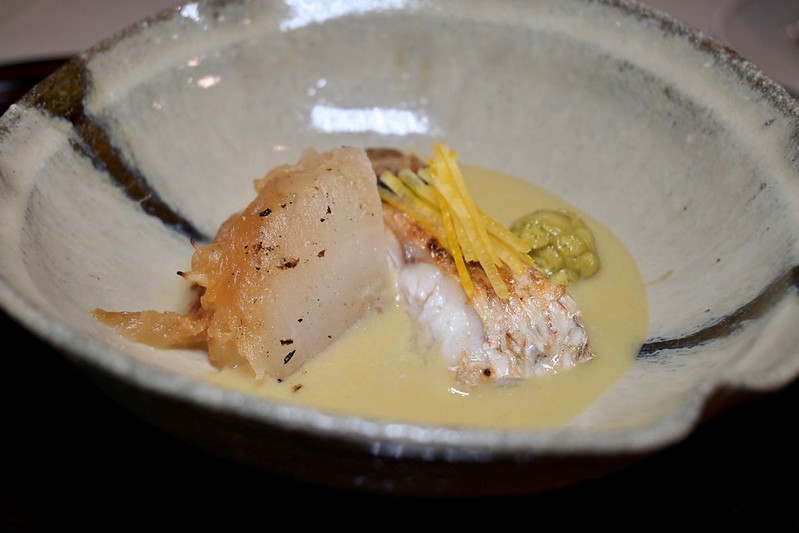~Invited Session~
Hanazen is one of the hottest tables (literally) in town today. The restaurant is headed by Chef
Yusuke Takada who is the founder of Osaka’s 2-Michelin-starred La Cime. Expect plenty of fire and
sear of the charcoal-grilled meat skewers and seafood prepared using the best of French and
Japanese ingredients and cooking techniques.
Hanazen will feature a single omakase dinner menu during the first phase of opening, priced at
S$250 for 16 courses. As the seasons change, Chef Takada will showcase different seasonal
ingredients so you will never be bored!
Hanazen’s Daily Soup
We started off with a clear comforting soup, which is a fragrant and clear broth of bonito and
chicken bones boiled for 6 hours. Felt like a warm hug!
Singa Dog
This dish was Chef Takada’s local reinterpretation of a hotdog, which also pays homage to his
famous dish, the Boudin Dog, that is found at La Cime. This was a breaded dough ball with chicken
floss and liver filling with edible charcoal, and brushed with a buah keluak sauce. I liked the chicken
liver filling and buah keluak combination!
Beef and Tuna tartlet
Wagyu tartar and akami is mixed with guacamole in a crisp beetroot tartlet shell, topped with ginger
flower and red amaranth leaves. This was a moreish morsel that left me wanting another one.
Panna Cotta
This was Chef Takada’s interpretation of a Singaporean Panna Cotta. The pandan velouté is filled
with seasonal Hamaguri clams from Japan which is naturally really sweet. It is accompanied by a side
of bread tuile and nanohana buds from the rapeseed plant and topped with caviar. A savory and
bittersweet combination that showcased Chef’s range of flavor profiles.
Sea Foie Gras / Choucroute / Urui
Ankimo liver, which in itself is one of my very favorite things, is steamed in a blend of sake and
cognac and served chilled in a tangy Alsatian-style choucroute dressing and topped with the shoots
of urui, a Japanese green vegetable. The urui’s wheat and grassy notes is a great foil for the palate
against the rich, fatty ankimo.
Chicken Heart, Mustard and Olive Sauce
I love chicken heart yakitori. This is expertly done, with the chewiness just right, and the
combination of the mustard and olive sauce makes this a winner.
Prawns and Chicken Tail, Porcini Sauce
We were advised to eat the prawn first, followed by the chicken tail, but to me the best way is just
to dive right in. Have it all together with the rich porcini sauce, and wash it down with a nice
Chardonnay.
Nodoguro, Fukinoto Miso Sauce / Grilled Turnip
Nodoguro, or blackthroated sea perch, is one of my favorite fish in the Japanese cuisine. It is meaty
and rich and creamy in flavor. This dish is paired with a wonderful fukinoto miso sauce which is I
think is a fantastic combination with the fish and grilled turnip.
Abalone, Chicken Gizzards, Gyoja-Ninniku Butter
Awabi abalone is prized for its size and meaty flavors. Chef Takada prepared this in advance for over
12 hours and it is cooked with radish, kombu and sake, and goes through a baptism of fire on the
binchotan. The result is a stick of chewy briny goodness that is combined with chicken gizzards with
yummy garlic chives butter.
Chicken Wing, Konbu Furikake
At first, I thought this was a morsel of chicken butt, which is usually seen in yakitori joints. Then I
realised that this was a deboned wing, and it was done with a hint of glazed konbu furikake brushed
on it. This brought out the clean flavors of the juicy chicken well; I just wished that there was more!
Lamb, Yoghurt Sauce
Baby lamb shoulder served with a creamy yogurt sauce with mint leaves. Nothing too complex, and
always a good combination.
Chicken Skin, Spices, Gochujang
I always like chicken skin for yakitori; gochujang is an interesting choice which was really strong for
the subtle taste of the chicken skin.
Chicken Liver with Raisin Sauce
I love chicken innards and chicken liver is a must for yakitori. This is served with a raisin sauce made
from three types of raisins and sweetened with tamarind and white wine. This gives it an interesting
profile of creamy poultry taste and sweet flavors juxtaposed with the grassy bitter taste profile of
the oba leaf.
Wagyu Ribeye, Périgueux Sauce
We arrived at the end of our meat courses with the decadent A5 Wagyu ribeye. Smoked with herbs
and grilled over the binchotan, the beef is so tender and soft that you could use a spoon to cut it
apart. Chef Takada also made a wonderful Perigueux sauce, which is a French classic sauce that is
usually made for steaks with Madeira, mixed with a Perigord truffle sauce.
Soumen, Warabi, Dashi
I really like the fact that the omakase meal had a soumen dish as it’s last savory dish. This was great
after all the grilled kushiyaki and yakitori dishes. Chicken umami flavours are strong in the broth, and
the use of warabi leaves (the one used in making of Japanese mochi) and dashi makes this one great
dish in buttoning up the tastebuds at the end of the omakase.
Hananzen Financier
This was cooked with chicken oil and lightly grilled over charcoal. It strangely works well with the
slight poultry taste. I wanted to take home a box of it.
Kyoto ‘Uji Matcha’ Ice Cream, Fermented Banana
The financier was also served with this wonderful matcha ice cream that was mixed with fermented
banana. The Uji Matcha ice cream was made in-house using specially selected tea leaves from
Kyoto’s (7 types of tea leaves!) and mixed with a fermented banana cream that was slightly sour.
This made sure that your taste buds are very lightly kissed with sweet and sour fruity flavors which
leave the night on a very satisfying note that is not too greasy.
Hanazen by Chef Yusuke Takada
CHIJMES


















Comments
Post a Comment